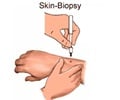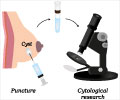An "optical biopsy" that has the potential to determine whether growths are cancerous without even puncturing the skin is being developed by a researcher at University of Florida.
Owing to the procedure, women may not have to endure the medical costs, stress and potential complications that accompany invasive biopsies forever."At this stage, it is just too early for optical tomography to be a screening tool. But you can pretty much say that it is highly likely it can become a diagnostic tool, an adjunct to X-ray mammography," said Dr. Huabei Jiang.
Jiang has devoted much of his career to an alternative to biopsies- "phase-contrast diffuse optical tomography"-a screening technology that roots out breast cancer not with cutting tools and laboratory tests but with light and computing power.
He recently completed the third generation of his apparatus - a bed with an array of fibre optic laser lights and detectors mounted within a hole where the patient places her breast.
Light from the harmless lasers enters the breast and scatters. While most gets absorbed in the tissue, some reaches the detectors.
With enough light hitting the detectors from enough different directions, there is sufficient data for Jiang's computer algorithms to create an image of the breast's interior.
Advertisement
But the image is just one indicator. In Jiang's newest apparatus, undergoing tests at the Tampa-based Moffitt Cancer Center, fibre optic lights span 10 different wavelengths, or colours.
Advertisement
Just as light collected from distant planets can reveal the composition of their atmospheres to astronomers, so light collected from these collisions can indicate chemical evidence of cancer.
A third technique, known as index refraction or phase contrast, provides information on cellular size and density - both factors that play into determination of cancer in laboratory biopsies.
His technique correctly identified biopsy, confirmed malignancies nearly 75 percent of the time, with the most accurate results from older patients, whose softer breasts make abnormalities more prominent.
Source-ANI
RAS















